
The Mitsubishi Sirius or 4G6/4D6 engine is the name of one of Mitsubishi Motors' four series of inline-four automobile engines, along with Astron, Orion, and Saturn.

The 6G7 series or Cyclone V6 engine is a series of V6 piston engines from Mitsubishi Motors. Five displacement variants were produced from 1986 to 2021, with both SOHC and DOHC, naturally aspirated and turbo charged layouts. While MIVEC variable valve timing has also been implemented in some versions the 2.5, 3.0, and 3.5 L versions were also available with gasoline direct injection. This engine has been the flagship powerplant of the company except when they briefly built a V8 in 1999–2001. The staple of their high-end sedans, it was given twin-turbos for the Mitsubishi GTO, and became the most powerful car ever built by the company at the time.
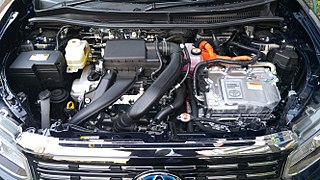
The Toyota NZ engine family is a straight-4 piston engine series. The 1NZ series uses aluminum engine blocks and DOHC cylinder heads. It also uses sequential fuel injection, and has 4 valves per cylinder with VVT-i.

The Toyota ZZ engine family is a straight-4 piston engine series. The ZZ series uses a die-cast aluminium engine block with thin press-fit cast iron cylinder liners, and aluminium DOHC 4-valve cylinder heads. The camshafts are chain-driven. The two 1.8 L members of the family, the 1ZZ and 2ZZ, use different bore and stroke. The former was optimised for economy, with torque emphasised in lower revolutions per minute operating range, while the latter is a "square" design optimised for high-RPM torque, yielding higher peak power. The ZZ family replaced the extremely popular cast-iron block 4A engines.

The Toyota AZ engine family is a straight-4 piston engine series. The AZ series uses an aluminium engine block with cast iron cylinder liners and aluminium DOHC cylinder head. The engine series features many advanced technologies including slant-squish combustion chambers, offset cylinder and crank centers, and the VVT-i continuously variable intake valve timing system. The aluminium engine measures 626 mm (24.6 in) long, 608 mm (23.9 in) wide, and 681 mm (26.8 in) tall.
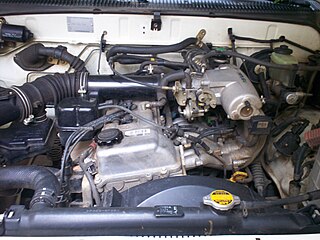
The Toyota RZ engine family is a straight-four piston engine series built in Japan. The RZ series uses a cast-iron engine block and aluminum SOHC or DOHC cylinder heads. It has electronic fuel injection (EFI), 2 or 4 valves per cylinder and features forged steel connecting rods.
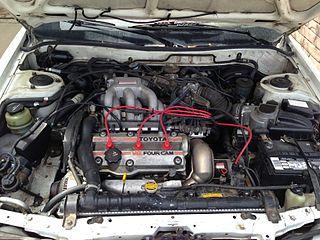
The Toyota VZ engine family is a series of V6 gasoline piston engines ranging from 2.0 to 3.4 L in displacement and both SOHC and DOHC configurations. It was Toyota's first V6 engine, being made as a response to Nissan’s VG engine, one of Japan’s first mass-produced V6 engines.

The Toyota R family was a series of inline-four gasoline automobile engines. Designed for longitudinal placement in such vehicles as the Celica and Hilux and in production from 1953 through 1997, usage faded out as many of Toyota's mainstream models moved to front-wheel drive. Overhead cam (OHC) versions featured a chain-driven camshaft.
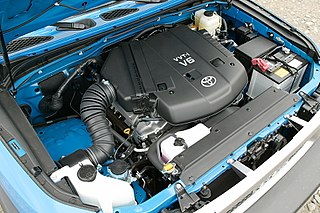
The Toyota GR engine family is a gasoline, open-deck, piston V6 engine series. The GR series has a 60° die-cast aluminium block and aluminium DOHC cylinder heads. This engine series also features 4 valves per cylinder, forged steel connecting rods and crankshaft, one-piece cast camshafts, a timing chain, and a cast aluminium lower intake manifold. Some variants use multi-port fuel injection, some have D4 direct injection, and others have a combination of direct injection and multi-port fuel injection or D4-S.
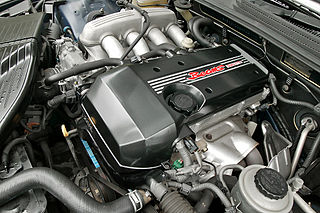
The Toyota S Series engines are a family of straight-four petrol engines with displacements between 1.8 and 2.2 litres, produced by Toyota Motor Corporation from January 1980 to August 2007. The S series has cast iron engine blocks and aluminium cylinder heads.

The Toyota E engine family is a straight-four piston engine series, and uses timing belts rather than chains. The E engines were the first multi-valve engines from Toyota designed with economy, practicality and everyday use in mind. Like many other Toyota engines from the era, the E engine series features a cast iron block, along with an aluminium cylinder head. E engines are lighter than earlier Toyota engines, due to the hollow crankshaft, thinned casting of the cylinder block, and several other reductions in auxiliaries as well as in the engine itself. Carbureted versions include a newly designed, variable-venturi carburetor. All of these changes improved economy and emissions. The members of the E engine family, range from 1.0 L to 1.5 L. The E family supplanted the K engines in most applications. A large number of parts in the E engine series are interchangeable between each other.

The Toyota HD is a series of Diesel engines produced by Toyota.
The Toyota KZ is one of Toyota's small passenger diesel engines.

The Toyota UR engine family is a 32-valve dual overhead camshaft V8 piston engine series which was first introduced in 2006, as the UZ series it replaced began phasing out. Production started with the 1UR-FSE engine with D-4S direct injection for the 2007 Lexus LS. The series launched with a die-cast aluminum engine block, aluminum cylinder heads and magnesium cylinder head covers. All UR engines feature variable valve timing for both intake and exhaust cams or Dual VVT-i. Timing chains are used to drive the camshafts. The UR engine has been produced in 4.6, 5.0, and 5.7-liter displacement versions.
The Toyota B engine family was a series of inline-four diesel engines.

The ZR engine is a family of straight-four 16-valve all-aluminum and water cooled gasoline engines with a die-cast aluminum block and variable valve timing developed by Toyota Motor Corporation, produced from 2007. Engines displace from 1.6 to 2.0 liters. Most engines in this family are equipped with Toyota's dual VVT-i technology that optimizes both intake and exhaust valve timing. This engine family is also the first to use Toyota's Valvematic system, first appearing on the Noah and Voxy in 2007 and then the European Avensis in 2009.

The Toyota SZ engine family is a series of straight-4 piston engines with a forward-facing exhaust. Toyota Motor Manufacturing (UK) in Deeside produces SZ engines for the Yaris. All three types of the SZ engine are built in Tianjin FAW Toyota Engine Co., Ltd. (TFTE) Plant No. 1 in Xiqing District, Tianjin, China. The 2SZ-FE and 3SZ-FE variations are also manufactured by PT Astra Daihatsu Motor's Karawang Engine Plant in Indonesia.
The ToyotaC engine family was a series of inline-4 diesel engines. There were two earlier generations of an engine Toyota named as the "Type C". The first generation was introduced in 1940 as a modification of the Type A engine. This first "Type C" was installed in the Toyota AE. The second generation was the first diesel engine at 1500cc used in the CS20 series 1959 Toyota Crown in October 1959. Japanese market vehicles with diesel engines were exclusive to Toyota Japan dealerships called Toyota Diesel Shop locations from 1979 until the dealership was cancelled in 1988.

The E0 series is a three-cylinder gasoline engine developed and manufactured by Honda, with a total displacement of 656 cc. The engine is intended for kei car applications. The E05A and E07A were partially replaced by the Honda P engine but as of 2020 the E07Z engine still saw use in the Acty truck.

The Toyota NR engine family is a series of small inline-four piston engines designed and manufactured by Toyota, with capacities between 1.2 and 1.5 litres.
















